Page last updated March, 7, 2024.
(S-Grille DeArmond copy pickup added. See below.)
Some pickups produced by other manufacturers are sometimes mistakenly assumed to have been manufactured by the Rowe Industries Inc./H. N. Rowe & Company/Rowe DeArmond Inc./DeArmond Inc./Tosh Electronics group of companies, all of Toledo, Ohio, USA. Some other pickups have been designed specifically to give this impression.
Some of the most common examples is shown below. Identifying these pickups in this manner does not infer technical criticism of them in any way, but merely clarifies their origin.
This site would gratefully appreciate any information on this particular subject.
Ovation
Several years ago, I came across a pickup factory-fitted in an Ovation Electric Storm Series guitar. This pickup had individual pole-pieces with the distinctive offset height-adjustment screws previously only seen in the DeArmond Model 2000 pickups, a.k.a. Dynasonic Fidela Tone pickups, as fitted in Gretsch guitars (and some of their Tenor guitars) from 1949 until 1957. That pickup is shown in the two photos below:


The underside of the pickup showed the same construction as the model 2000, down to the four ‘crimping’ indents in the brass attachments for the pole-pieces. To check this, I contacted Ovation, who could not confirm either way. Much later, I contacted Schaller, who confirmed that all of the Electric Storm Series of pickups had, in fact, been manufactured by them. One proof of this for Schaller was the purely decorative raised ridge around the front face of the pickup bezel. This feature is common for all of the pickups in this range and is included in some Hofner pickup bezels, also manufactured by Schaller.
Guild
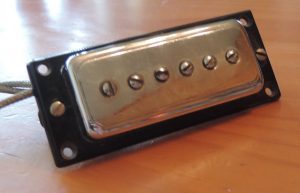
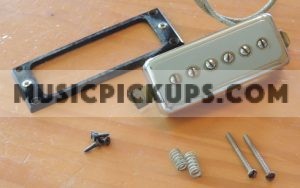
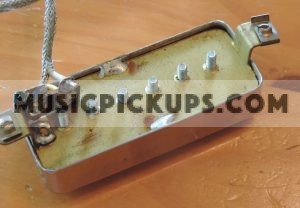
This pickup from 1964, shown here with a chrome top, but also available with either a black or white top, installed in some Guild guitars including the X-50 archtop, were not manufactured by DeArmond. It is likely that they were manufactured by the same company that manufactured Guild’s chrome humbuckers, because the above pickup’s connections terminate in a very small insulated connector unit exposed on the underside of the pickup – the same arrangement as on Guild’s humbucker model HB-1 (photos B0550 – copyright ).
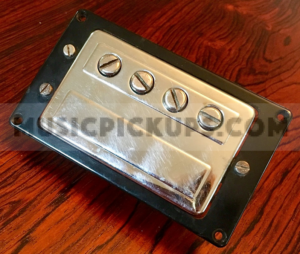
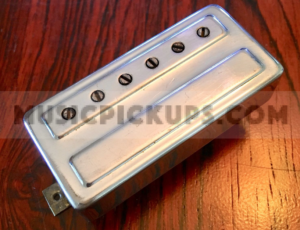
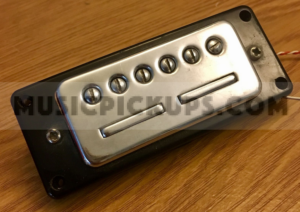
The three pickups above have been ascribed to Guild/DeArmond, but they are definitely not by DeArmond, as produced in Toledo, Ohio (B0574. Photos copyright The Bonfires Vintage – Kevin).
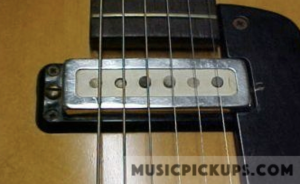
This single-coil pickup with non-adjustable individual pole-pieces s fitted in some Guild Guitars, and is sometimes referred to as the ‘Mickey Mouse’ pickup. In Guild’s 1969 catalog, it is shown in a T-100D ‘Slim Jim’ guitar and is described as a Frequency-Tested’ pickup. It was not manufactured by DeArmond.
Magnatone
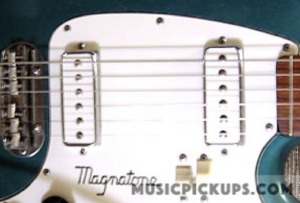
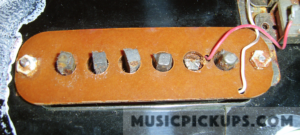
The two photos above show the loaded pickguard from a Magnatone Zephyr guitar. The pickups appear quite similar to DeArmond’s when viewed from the front but when viewed from underneath, it is clear that they are not.
Kay
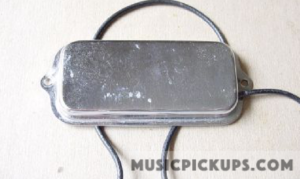
This pickup was fitted to a number of Kay guitars. The cover and bezel were manufactured as one pressing. The pickup is quite shallow, enabling it to be surface-mounted on a pickguard or recessed with the bezel hidden. The date of manufacture was sometimes stamped in ink on the underside of the pickup. Note the closeness of the two fixing holes to the pickup body proper. Several cosmetic variations to the plain chrome top exist, including an embossed diamond pattern and a printed black and white pattern.
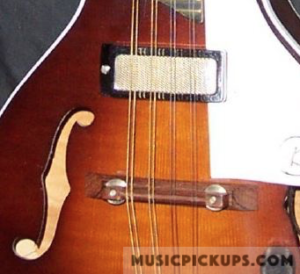
This pickup fitted to a Kay mandolin was manufactured by Kay.
Teisco?
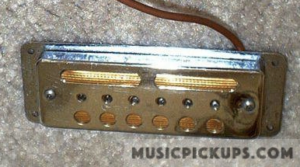
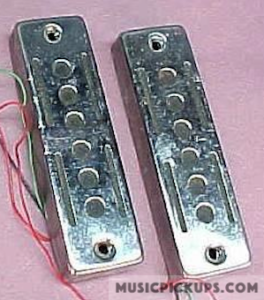
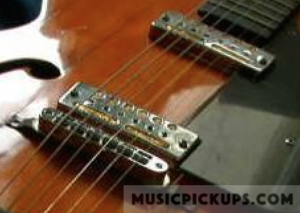
The three pickup types above, found on a number of Japanese guitars, may have been manufactured by Teisco. The combination of gold-filled slots and pole openings could lead to mistaken identity as DeArmond items.
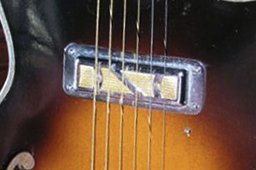
This pickup is deliberately reminiscent of the DeArmond S-Grille and D-Grille pickups.

This pickup is a version of the pickup above, fitted with adjustable pole-pieces
Kay
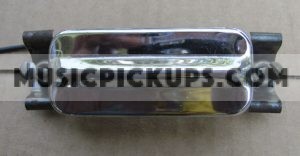
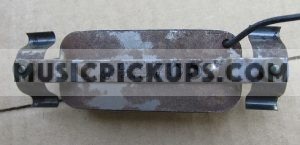
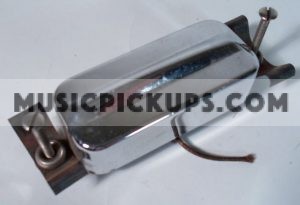
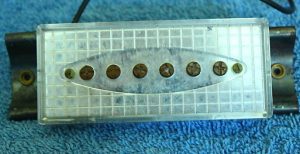
Two guitar pickups factory-fitted in some Kay guitars are not by DeArmond. Photos 1, 2 & 3 above show Kay’s ‘Speedbump’ guitar pickup. Photo 4 shows a pickup with a distinctive design, often referred to as a ‘Kleenex Box’ type. Their method of construction is very different to any DeArmond pickup seen to date.
Schaller?
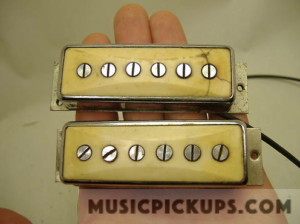
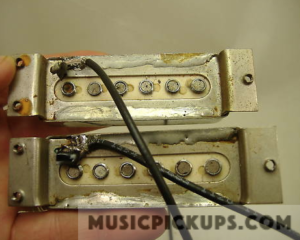
The pickups in the two photos above appear quite similar to DeArmond’s recessable version of the Model 210, and may be by Schaller
Gibson
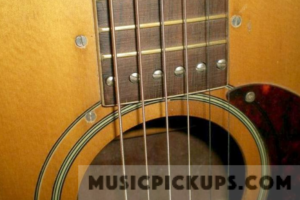
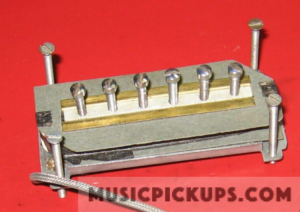
The pickup shown above, factory-fitted in a Harmony H55 Sovereign Jumbo acoustic guitar is a version of the Gibson P-13 pickup. The four visible fixing screws help identify the pickup as such (photo copyright Francois Demont).
Harmony
The pickup below shown in a Harmony H655 Sovereign Jumbo acoustic guitar is a DeArmond pickup with adjustable pole-pieces, with acoil; structure similar to DeArmond’s Model 55. The two visible fixing screws inline with the pole-pieces, the two rivets between the pole-pieces and the translucent white nylon spacer above the coil help identify the pickup as such (photo copyright Francois Demont).
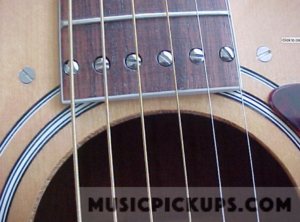
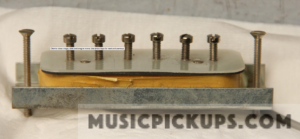
This attachable guitar pickup range shown below, suitable for installation in a flat-top round-hole guitar, branded DeArmond and labelled DeArmond Tone Boss, has recently been produced by Guild/Cordoba.
Cordoba
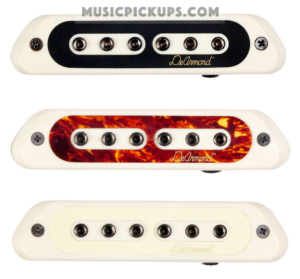
DeArmond reproduction pickups:
Some pickups have been produced by other manufacturers to at least visually resemble original DeArmond pickups. A market for these items exists because of the high cost of the originals. Some of these pickups are shown below:
Repro S-Grille soapbar pickup:
Manufacturer unknown
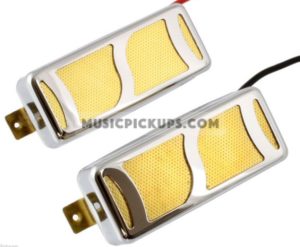
This pickup has no visible rivets and is secured by two screws at opposite ends of the pickup, similar to a Fender Stratocaster pickup. DeArmond’s version had a plastic bezel in either cream/white or in black See Harmony Mandolin model ;ldoes not require a cutout, as it is surface-mounted, being fixed with solid rivets through pickguard material, or fitted in a white or black bezel. This pickup could be fitted neatly into a plastic pickguard.
This a newly manufactured pickup and was selling as new on eBay.com in March, 2024. It is very similar in appearance to the original DeArmond pickup produced in Toledo, Ohio. A dimensioned drawing is also shown, making it easier to answer the question “Will it fit?”. Magnetic field strength and polarity, coil resistance and inductance are not shown. The texture of the gold foil material is not as that in the original DeArmond pickups.
Repro four-scroll (a.k.a.) Moustache pickup:
Manufacturer unknown
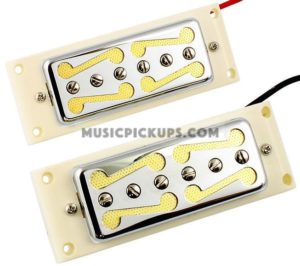
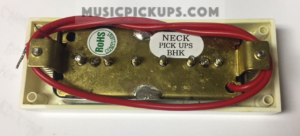
Note the two height adjustment screws which project into the guitar body below and the absence of two rivets between the poles. This pickup has the same frame and fixing arrangement as the D-Grille pickup above. It has has no visible rivets and is secured by two screws at opposite ends of the pickup, as shown. The white plastic bezel differs from the DeArmond version, having the two holes in line with the pole-pieces’ axis. The short ends of the bezel are curved. The original bezel had chamfered edges all round.
The DeArmond range of guitars and basses was introduced by Fender in the 1990s. One pickup from that range visually resembles the original Model 2000 (a.k.a. Gretsch Dynasonic Fidela tone ) and is shown below.
Fender, 1990s
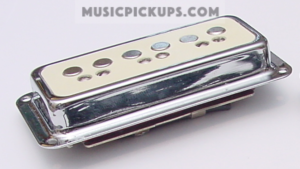
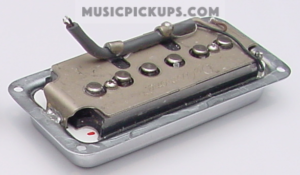
The above pickup is Fender’s Model 2K. While the upper, normally visible part of the pickup is very similar in appearance to DeArmond’s Model 2000, the underside is very different. ‘DeArmond’ is embossed into one end of this pickup and is visible when installed in an instrument.
Fender’s pickup uses one flat bar magnet positioned on each side of the poles, creating a similar magnetic field path to Gibson’s P-90 pickup.
The Dearmond Rhythm Chief pickups models 1000 (no individual poles) and 1100 (individually adjustable poles) are justifiably much sought after and as a result, can command high prices in the secondhand market. This demand has resulted in a number of companies producing visually very similar pickups. The following photos are shown to help in distinguishing an original vintage Rowe DeAmond pickup from a more recent reproduction.
Model 1000 Rhythm Chief – Reproduction 1:
Cordoba
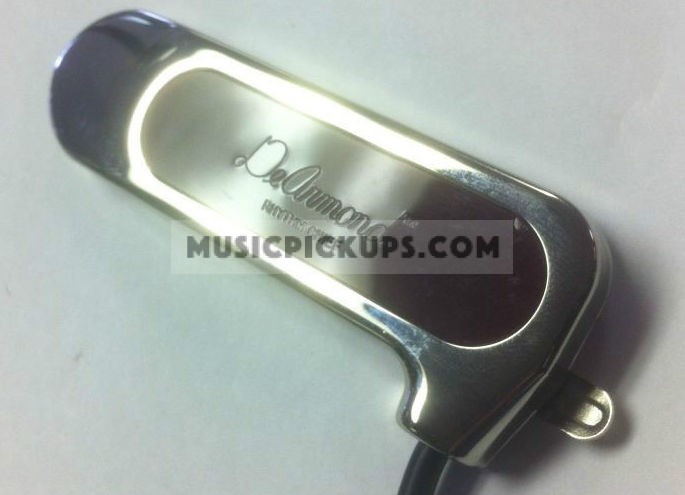
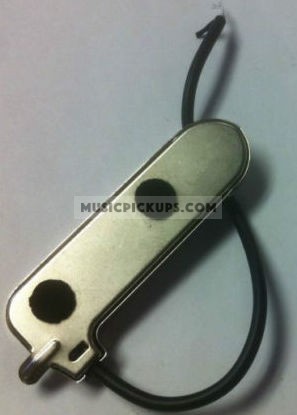
This version is sold in chrome or gold finish, with a short neck-fixing arm but without controls box, pressure rod or clamp. It is factory-fitted on some Guild archtops and is widely available, but only with a short neck-fixing rod and without any controls. Note that the pickup’s front insert states ‘DeArmond Rhythm Chief’. DeArmond’s own pickup insert is shown below:
Swingmaster, Europe
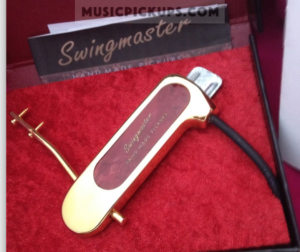
The tab for fitting under the pickguard is wider than on the original. Also, the text in the maroon insert says ‘Swingmaster’
DeArmond
DeArmond produced several variations of the Model 1000 as shown below:
DeArmond’s Model 1000’s text is seen here
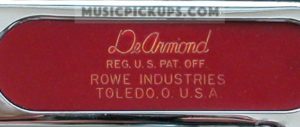


The three photos above show the text as embossed on the Model 1000 pickup. The first photo shows the standard Model 1000 with a red insert and text. The insert was originally black, when introduced in 1948, with the metalwork finished in chrome. The insert was later maroon to dark red in color, such as seen here. This model came with the pressure rod, clamp and controls box with volume and tone controls and a solo/rhythm push switch.
The second and third photos above show the insert as supplied with the Model 1000 as factory-fitted in Guild’s Artist Award archtop guitar, endorsed by Johnny Smith. The finishes were white with black lettering or black with gold lettering. This pickup was attached to the upper side of the instrument’s neck, with a volume control in a metal ‘cup’ (DeArmond’s own terminology) fixed through the pickguard. Originally a male screw connector was fitted to the cop and thi was later changed to a mini-jack socket.
Repro Model 1100 Adjustable Rhythm Chief – Version 1:
Cordoba
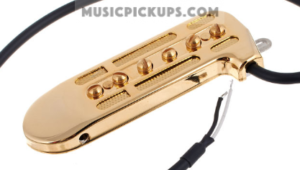
This pickup is sold in gold finish with a short neck-fixing arm but without controls box. This pickup is widely available. This pickup and the Repro Model 1000 Rhythm Chief – Version 1 (shown above) would appear to be from the same source. As with the other ‘ DeArmond lookalike” Model 1000 above, this pickup also comes with a short neck-fixing rod and without any controls. One obvious difference between the original DeArmond Model 1100 and this version is that the two rivets between the pole-pieces are slightly rounded in the original. See photo of Model 1100 below for comparison:
DeArmond

